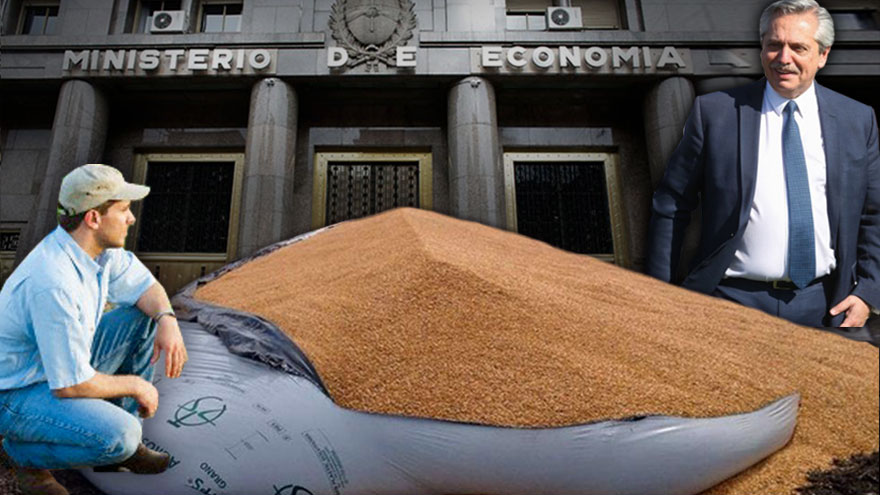In a context in which the price of oil plummets, the product most exported by Argentina faces a harsh panorama
In a true “black monday” for the markets, the soybean did not manage to leave the combo formed by the oil crash (in the middle of a dispute between Russia and OPEC) and the worsening of the coronavirus.
The spread of this disease worldwide and its impact on various branches of activity, such as tourism and sports, is fully affecting the markets, which provide for a lower growth of the world economy, starting with China, one of the big affected.
“Currently, the coronavirus It continues to spread and it is not known exactly how much more it will take to control its effects on human life. However, it is possible to notice that due to the cessation of productive activity in the main industrial region of China, both the demand and the supply of the Asian giant has been cut by putting a limit on its growth possibilities in 2020. The fall in consumption Chinese is reflected in a falling commodity prices, and adds a strong bearish foundation to the market of the soy that goes through a phase of clear stagnation, “they warned from the Rosario Stock Exchange.
This Monday, the commodities market could not escape the collapse of the markets: in Chicago, the reference market, the soy and corn exhibited falls of 2% and 1% respectively.
The soybean contracts for March closed at US $ 317.29 a ton, about US $ 7.26 less than Friday, while for May they ended at US $ 319.68, about US $ 7.81 less. These are minimum values for 2020.
According to experts, global stock markets fell when investors fled to bonds to cover themselves before the shock caused by the coronavirus, while oil collapsed to 33% (then cut losses) after Saudi Arabia launched a price war with Russia.
“Soybeans and corn are falling due to weakness in foreign markets“said Matt Ammermann, commodity risk manager at INTL FCStone.
“The prices of the Petroleum they have dropped sharply and fears of the coronavirus are depressing stock markets, “he added.
And this is also impacting at the local level, to which was added the unemployment decreed by rural entities, which depressed the realization of business at minimum levels.
The soy, with delivery until March 15, It was negotiated at US $ 220, US $ 1 below the last wheel.
Coronavirus and soybean price: everyone looks at China
When drawing projections, analysts look closely at the behavior of China, which last December had signed with the United States the “Phase One” of trade agreements with which they pledged to end the trade war that Donald had been maintaining Trump and Xi Jinping.

“In the ‘Phase One’ agreement, China pledged to acquire US agricultural products for more than US $ 40,000 million in 2021. This objective, which was already very ambitious at the time of signing the agreement currently seems even more distant as a result of coronavirus outbreak“, they warned from the Rosario Stock Exchange.
In the report they warned that, in fact, the agreement states that purchase commitments by China they will be sustained “only to the extent that there is an internal demand”.
In line with this, it is established that commercial objectives may not be met in the event of a contraction in demand, due to an unpredictable event.
“At first, the coronavirus spread in China it would fit into this definition and could result in lower purchases of US agricultural products by China“, explained from the BCR, making it clear that this will act as a bearish factor.
“A deepening of the fall in Chinese demand for soy American would contribute to stagnation of soybean prices in Chicago, which are taken as a reference in the international market. The soybean values, which grew propelled by the consumption of the Asian giant for more than a decade until reaching a peak in 2012 since then undergo a weakening, “they completed.
They then drew a distinction between the 2003 SARS outbreak and the current effect of the coronavirus: “While it is interesting to analyze what happened in 2003, the current situation is considerably different. While at that time the Chinese GDP represented 4% of the world product, currently its economy contributes 17% of global GDP. Consequently, any alteration in the Chinese economic matrix today will have a much greater impact on the world than 20 years ago. “

As a consequence, among other things, of outbreak of coronavirus, the Bloomberg economic team projected a drop in the growth rate to 4.5% in the first quarter of 2020, even considering a scenario where the virus is controlled.
“Being the second economy in the world and with a GDP that contributes 17% of the global product, it is expected that a fall in the rate of Chinese activity translates into lower world growth, which in the last 7 years has been showing a rate below 4%, “they warned from the BCR.
How will it hit Argentina? From the Stock Exchange they explained that the main suppliers of China, such as Australia and Brazil (which is, in turn, Argentina’s first business partner) they will grow less because of the coronavirus effect.
Around 40% of exports of both Brazilian and Australian commodities are directed to the Chinese market, so Bloomberg anticipates a 0.3% reduction in the growth rates of both countries in the southern hemisphere.
Although the participation of the Asian giant in Argentine exports does not have such a decisive weight as in the cases of Brazil, from the BCR they warned that “also our country will see its economic performance deteriorated from the situation in China“, to which is added an indirect impact due to the lower growth of the neighboring country.

Coronavirus and soy: more problems for Argentina
To the problems arising from the outbreak of coronavirus and the drop of the Petroleum, the climatic factor.
From the BCR they warned that there are almost 1.8 million hectares of soybeans in regular to bad conditions.
“Fenced by lack of water, the production of soy in the core region it would fall to 18 million tons when 20 million tons were estimated a month ago, “they warned in a report.
That is, they would be obtained 2 million tons of soy less than expected.
“The situation is complicated in the short term“, commented José Luis Aiello, doctor of Atmospheric Sciences.
How much and when it rains will be essential to minimize the damage, although experts warn that, whatever happens from now on, losses of between 20% and 30% will have to be faced.
To the east of the core zone, the losses are 80% of the yield. Some engineers explain that they rarely saw something like that, so abrupt.
“You can tell they ran out of profiles. The change was so fast: they went from an intense green to a mosaic of brown hues in a week.” The best lots in the area are those in the west of the region, but, while maintaining high expectations, there are also yield discounts. This, of course, could translate into less Dollars in the domestic market, a key point that should be closely monitored by the Government of Alberto Fernández.
Find out the latest on digital economy, startups, fintech, corporate innovation and blockchain. CLICK HERE

Corresponsal de Argentina, Encargado de seleccionar las noticias más relevantes de su interés a nuestro sitio web NewsPer.com





